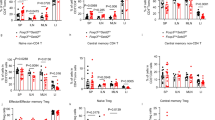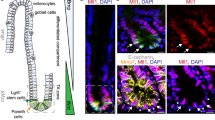Abstract
Tightly regulated at the level of transcription, expression of MHC class II molecules varies significantly among gastrointestinal cancers. High levels of MHC class II expression are often associated with a better prognosis, which is indicative of the involvement of CD4+ lymphocytes in tumor suppression, but the molecular mechanism by which MHC class II expression is regulated remains unclear. In the present study, we investigated the expression of one inducible MHC class II molecule, HLA-DR, and its coactivators in a panel of colorectal and gastric cancer cell lines. Interferon-γ induced expression of HLA-DR in 14 of 20 cell lines tested; the remaining six cell lines did not express HLA-DR. Analysis of the expression of transcription factors and coactivators associated with HLA-DR revealed that the loss of CIITA expression was closely associated with the absence of HLA-DR induction. Moreover, DNA methylation of the 5′ CpG island of CIITA-PIV was detected in all cancer cells that lacked CIITA. The methylation and resultant silencing of CIITA-PIV depended on the activities of two DNA methyltransferases, DNMT1 and DNMT3B, and their genetic inactivation restored CIITA-PIV expression. It thus appears that CIITA methylation is a key mechanism that enables some gastrointestinal cancer cells to escape immune surveillance.
This is a preview of subscription content, access via your institution
Access options
Subscribe to this journal
Receive 50 print issues and online access
$259.00 per year
only $5.18 per issue
Buy this article
- Purchase on Springer Link
- Instant access to full article PDF
Prices may be subject to local taxes which are calculated during checkout









Similar content being viewed by others
References
Abril E, Real LM, Serrano A, Jimenez P, Garcia A, Canton J, Trigo I, Garrido F and Ruiz-Cabello F . (1998). Cancer Immunol. Immunother., 47, 113–120.
Andersen SN, Rognum TO, Lund E, Meling GI and Hauge S . (1993). Br. J. Cancer, 68, 80–85.
Armstrong TD, Clements VK, Martin BK, Ting JP and Ostrand-Rosenberg S . (1997). Proc. Natl. Acad. Sci. USA, 94, 6886–6891.
Armstrong TD, Clements VK and Ostrand-Rosenberg S . (1998). J. Immunol., 160, 661–666.
Baylin SB, Esteller M, Rountree MR, Bachman KE, Schuebel K and Herman JG . (2001). Hum. Mol. Genet., 10, 687–692.
Clark SJ, Harrison J, Paul CL and Frommer M . (1994). Nucleic Acids Res., 22, 2990–2997.
Croce M, De Ambrosis A, Corrias MV, Pistoia V, Occhino M, Meazza R, Giron-Michel J, Azzarone B, Accolla RS and Ferrini S . (2003). Oncogene, 22, 7848–7857.
Fahrner JA, Eguchi S, Herman JG and Baylin SB . (2002). Cancer Res., 62, 7213–7218.
Garrido F and Algarra I . (2001). Adv. Cancer Res., 83, 117–158.
Jones PA and Baylin SB . (2002). Nat. Rev. Genet., 3, 415–428.
Kaklamanis L and Hill A . (1992). Cancer Surv., 13, 155–171.
Kanaseki T, Ikeda H, Takamura Y, Toyota M, Hirohashi Y, Tokino T, Himi T and Sato N . (2003). J. Immunol., 170, 4980–4985.
Kondo Y, Shen L and Issa JP . (2003). Mol. Cell Biol., 23, 206–215.
Landis SH, Murray T, Bolden S and Wingo PA . (1999). CA Cancer J. Clin., 49, 8–31, 1.
Lennon AM, Ottone C, Rigaud G, Deaven LL, Longmire J, Fellous M, Bono R and Alcaide-Loridan C . (1997). Immunogenetics, 45, 266–273.
Liang G, Robertson KD, Talmadge C, Sumegi J and Jones PA . (2000). Cancer Res., 60, 4907–4912.
Lovig T, Andersen SN, Thorstensen L, Diep CB, Meling GI, Lothe RA and Rognum TO . (2002). Br. J. Cancer, 87, 756–762.
Magdinier F and Wolffe AP . (2001). Proc. Natl. Acad. Sci. USA, 98, 4990–4995.
McDougall CJ, Ngoi SS, Goldman IS, Godwin T, Felix J, DeCosse JJ and Rigas B . (1990). Cancer Res., 50, 8023–8027.
Meazza R, Comes A, Orengo AM, Ferrini S and Accolla RS . (2003). Eur. J. Immunol., 33, 1183–1192.
Morris AC, Spangler WE and Boss JM . (2000). J. Immunol., 164, 4143–4149.
Muhlethaler-Mottet A, Otten LA, Steimle V and Mach B . (1997). EMBO J., 16, 2851–2860.
Nakagawachi T, Soejima H, Urano T, Zhao W, Higashimoto K, Satoh Y, Matsukura S, Kudo S, Kitajima Y, Harada H, Furukawa K, Matsuzaki H, Emi M, Nakabeppu Y, Miyazaki K, Sekiguchi M and Mukai T . (2003). Oncogene, 22, 8835–8844.
Neugut AI, Hayek M and Howe G . (1996). Semin. Oncol., 23, 281–291.
Nguyen CT, Weisenberger DJ, Velicescu M, Gonzales FA, Lin JC, Liang G and Jones PA . (2002). Cancer Res., 62, 6456–6461.
Ossendorp F, Toes RE, Offringa R, van der Burg SH and Melief CJ . (2000). Immunol. Lett., 74, 75–79.
Rhee I, Bachman KE, Park BH, Jair KW, Yen RW, Schuebel KE, Cui H, Feinberg AP, Lengauer C, Kinzler KW, Baylin SB and Vogelstein B . (2002). Nature, 416, 552–556.
Rhee I, Jair KW, Yen RW, Lengauer C, Herman JG, Kinzler KW, Vogelstein B, Baylin SB and Schuebel KE . (2000). Nature, 404, 1003–1007.
Santini V, Kantarjian HM and Issa JP . (2001). Ann. Intern. Med., 134, 573–586.
Sengupta PK, Smith EM, Kim K, Murnane MJ and Smith BD . (2003). Cancer Res., 63, 1789–1797.
Suzuki H, Itoh F, Toyota M, Kikuchi T, Kakiuchi H and Imai K . (2000). Cancer Res., 60, 4353–4357.
Takamura Y, Ikeda H, Kanaseki T, Toyota M, Tokino T, Imai K, Houkin K and Sato N . (2004). Glia, 45, 392–405.
Ting JP and Trowsdale J . (2002). Cell, 109 (Suppl), S21–S33.
Toes RE, Ossendorp F, Offringa R and Melief CJ . (1999). J. Exp. Med., 189, 753–756.
Toyota M, Sasaki Y, Satoh A, Ogi K, Kikuchi T, Suzuki H, Mita H, Tanaka N, Itoh F, Issa JP, Jair KW, Schuebel KE, Imai K and Tokino T . (2003). Proc. Natl. Acad. Sci. USA, 100, 7818–7823.
van den Elsen PJ, Gobin SJ, van der Stoep N, Datema G and Vietor HE . (2001). J. Reprod. Immunol., 52, 129–145.
Waldburger JM, Suter T, Fontana A, Acha-Orbea H and Reith W . (2001). J. Exp. Med., 194, 393–406.
Xiong Z and Laird PW . (1997). Nucleic Acids Res., 25, 2532–2534.
Yazawa T, Ito T, Kamma H, Suzuki T, Okudela K, Hayashi H, Horiguchi H, Ogata T, Mitsui H, Ikeda M and Kitamura H . (2002). Am. J. Pathol., 161, 291–300.
Acknowledgements
We thank Dr William F Goldman for editing the manuscript. This study was supported in part by Grants-in-Aid for Scientific Research on Priority Areas from the Ministry of Education, Culture, Sports, Science, and Technology (MT, TT and KI). AS is a research fellow from the Japanese Society for the Promotion of Science. MT is a scholar supported by Research Grant of the Princess Takamatsu Cancer Research Fund.
Author information
Authors and Affiliations
Corresponding author
Rights and permissions
About this article
Cite this article
Satoh, A., Toyota, M., Ikeda, H. et al. Epigenetic inactivation of class II transactivator (CIITA) is associated with the absence of interferon-γ-induced HLA-DR expression in colorectal and gastric cancer cells. Oncogene 23, 8876–8886 (2004). https://doi.org/10.1038/sj.onc.1208144
Received:
Revised:
Accepted:
Published:
Issue Date:
DOI: https://doi.org/10.1038/sj.onc.1208144
Keywords
This article is cited by
-
Engineering universal cells that evade immune detection
Nature Reviews Immunology (2019)
-
Targeting epigenetic regulators for cancer therapy: mechanisms and advances in clinical trials
Signal Transduction and Targeted Therapy (2019)
-
Association of high CD4-positive T cell infiltration with mutations in HLA class II-regulatory genes in microsatellite-unstable colorectal cancer
Cancer Immunology, Immunotherapy (2015)
-
Absent in Melanoma 2 (AIM2) is an important mediator of interferon-dependent and -independent HLA-DRA and HLA-DRB gene expression in colorectal cancers
Oncogene (2012)
-
Identification of target genes for wild type and truncated HMGA2 in mesenchymal stem-like cells
BMC Cancer (2010)



